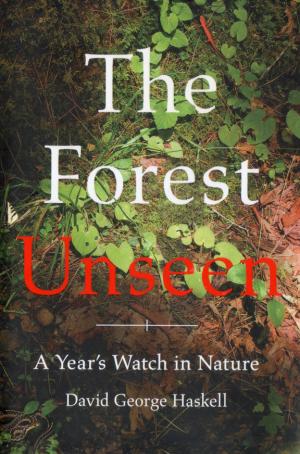By Nancy Brannon, Ph.D.
If have not been keeping up with the Mississippi Hill County Book Club at Strawberry Plains Audubon Center (SPAC), you have some catching up to do with a fascinating book: The Forest Unseen by David George Haskell. The book club meets every first Tuesday at 6 p.m. at the historic Davis House at SPAC, so there is still time to join, and this is the book they began discussing February 7th. I think you will find the book a fascinating read that will open up new worlds to your consciousness and imagination.
About the book: The book details the experience of Sewanee: The University of the South biology professor David Haskell watching one meter of forest on the mountain slopes in southeast Tennessee – on the western escarpment of the Cumberland Plateau. He chose a place with a sandstone rock that he could be fairly comfortable sitting on for long periods of time, and began observations of an area he had not seen before. Over the course of a year (and now many years), he made frequent pilgrimages to this spot along a slope in an old-growth Tennessee forest to observe. He opened his senses to see what was happening in this one square meter of forest and used a notebook to record his observations.
His guiding metaphor for this project was the mandala. The mandala is a sand sculpture with multiple colored sands created into a geometric composition, and serves as a tool for guiding individuals along the path to enlightenment.
“Creating a sand mandala is an act of meditation and training the memory. By focusing in, the paradox is that you see further,” Haskell explains. He applied this approach in an ecological context. The square meter served as a device to focus his attention, a way of structuring the narrative of the book, as well as an intriguing “hook” for generating interest in the book. “Unless we know our homes, our places, we have nothing to offer the global conversation,” he says.
He went into the forest without an agenda – just to see where his observations would take him. However, “We can never enter the world without preconceived ideas,” he qualifies. But his meditation experience allowed him to let go of judgment and be there for whatever arises, while “attending to the senses of this really amazing forest,” he said.
For him, there’s also an aesthetic component to this – connecting to stories of ecology and evolutionary history, and writing in a way that people might find worth reading! “It’s not just other species we learn about,” e.g., chickadees, “it’s also ourselves,” he concludes. “Out of these seeming minutiae the whole world is woven.” This book is about taking those humble little creatures and holding them up for examination, for understanding, so we can become more ecologically literate. The notion that nature is somewhere “out there” and there’s a division between us and nature is an illusion, a falsehood. He tries “to help people see what mostly we walk by and never even see, and, second, to feel some curiosity or some wonder about it.”
Another theme in the book is the power and the ubiquity of biological networks. He describes extensively the “alarm call” passed on from one species to another where there is a potential threat in the woods, i.e., himself. He says there is an acoustic in the woods that we are “unplugged” from, but the other animals in the woods are intently attuned to. But we have the ability to tune back in just by paying attention to their acoustic network. This leads him into descriptions of other kinds of networks in the forest, e.g., the plant network.
Discovering these networks leads to the idea of “realizing that the ‘self’ is an illusion; what really matters is the network – the relationships and connections among what we formerly would have referred to as ‘selves.’ The key message is I’m not a self; I’m a walking community. …Our consciousness is the product of a network, of an ecological community.”
The roots of this book are in natural history, biology, knowing communities, local knowledge, knowing the biodiversity, the ecological stories of home that, traditionally, are important for survival. “Through the particularity, you can get to the universal. The two feed each other,” he states.
Turning this small patch of forest into his own natural laboratory, Haskell reveals the science behind moments of beauty, delighting in the resourcefulness of spring wildflowers, and musing on the ecological partnerships that sustain lichens and other creatures. Throughout, Haskell shows the complexity and interdependence of the natural world.
The Buddhist art of the mandala contemplates the importance of close observation of the world around us. Haskell finds that this tiny spot of woods contains a teeming soup of life beyond the comprehension of our limited human senses. This informative and inspiring narrative will give readers some new things to pay attention to when walking through the woods – or in your own backyard.
About the author: Haskell received his B.A. degree at the University of Oxford, UK and his Ph.D. from Cornell University.
Read more about Haskell’s research and scholarship at: http://biology.sewanee.edu/facstaff/haskell
View a video about the book at: https://www.youtube.com/watch?v=TqXN-IGxwSo
View Haskell’s lecture at Yale University in 2014 about his book, The Forest Unseen at: https://www.youtube.com/watch?v=SxGPsQMsFZQ
Read other book reviews by Steve Donoghue at: http://www.openlettersmonthly.com/book-review-the-forest-unseen/ and at Publishers Weekly.
If have not been keeping up with the Mississippi Hill County Book Club at Strawberry Plains Audubon Center (SPAC), you have some catching up to do with a fascinating book: The Forest Unseen by David George Haskell. The book club meets every first Tuesday at 6 p.m. at the historic Davis House at SPAC, so there is still time to join, and this is the book they began discussing February 7th. I think you will find the book a fascinating read that will open up new worlds to your consciousness and imagination.
About the book: The book details the experience of Sewanee: The University of the South biology professor David Haskell watching one meter of forest on the mountain slopes in southeast Tennessee – on the western escarpment of the Cumberland Plateau. He chose a place with a sandstone rock that he could be fairly comfortable sitting on for long periods of time, and began observations of an area he had not seen before. Over the course of a year (and now many years), he made frequent pilgrimages to this spot along a slope in an old-growth Tennessee forest to observe. He opened his senses to see what was happening in this one square meter of forest and used a notebook to record his observations.
His guiding metaphor for this project was the mandala. The mandala is a sand sculpture with multiple colored sands created into a geometric composition, and serves as a tool for guiding individuals along the path to enlightenment.
“Creating a sand mandala is an act of meditation and training the memory. By focusing in, the paradox is that you see further,” Haskell explains. He applied this approach in an ecological context. The square meter served as a device to focus his attention, a way of structuring the narrative of the book, as well as an intriguing “hook” for generating interest in the book. “Unless we know our homes, our places, we have nothing to offer the global conversation,” he says.
He went into the forest without an agenda – just to see where his observations would take him. However, “We can never enter the world without preconceived ideas,” he qualifies. But his meditation experience allowed him to let go of judgment and be there for whatever arises, while “attending to the senses of this really amazing forest,” he said.
For him, there’s also an aesthetic component to this – connecting to stories of ecology and evolutionary history, and writing in a way that people might find worth reading! “It’s not just other species we learn about,” e.g., chickadees, “it’s also ourselves,” he concludes. “Out of these seeming minutiae the whole world is woven.” This book is about taking those humble little creatures and holding them up for examination, for understanding, so we can become more ecologically literate. The notion that nature is somewhere “out there” and there’s a division between us and nature is an illusion, a falsehood. He tries “to help people see what mostly we walk by and never even see, and, second, to feel some curiosity or some wonder about it.”
Another theme in the book is the power and the ubiquity of biological networks. He describes extensively the “alarm call” passed on from one species to another where there is a potential threat in the woods, i.e., himself. He says there is an acoustic in the woods that we are “unplugged” from, but the other animals in the woods are intently attuned to. But we have the ability to tune back in just by paying attention to their acoustic network. This leads him into descriptions of other kinds of networks in the forest, e.g., the plant network.
Discovering these networks leads to the idea of “realizing that the ‘self’ is an illusion; what really matters is the network – the relationships and connections among what we formerly would have referred to as ‘selves.’ The key message is I’m not a self; I’m a walking community. …Our consciousness is the product of a network, of an ecological community.”
The roots of this book are in natural history, biology, knowing communities, local knowledge, knowing the biodiversity, the ecological stories of home that, traditionally, are important for survival. “Through the particularity, you can get to the universal. The two feed each other,” he states.
Turning this small patch of forest into his own natural laboratory, Haskell reveals the science behind moments of beauty, delighting in the resourcefulness of spring wildflowers, and musing on the ecological partnerships that sustain lichens and other creatures. Throughout, Haskell shows the complexity and interdependence of the natural world.
The Buddhist art of the mandala contemplates the importance of close observation of the world around us. Haskell finds that this tiny spot of woods contains a teeming soup of life beyond the comprehension of our limited human senses. This informative and inspiring narrative will give readers some new things to pay attention to when walking through the woods – or in your own backyard.
About the author: Haskell received his B.A. degree at the University of Oxford, UK and his Ph.D. from Cornell University.
Read more about Haskell’s research and scholarship at: http://biology.sewanee.edu/facstaff/haskell
View a video about the book at: https://www.youtube.com/watch?v=TqXN-IGxwSo
View Haskell’s lecture at Yale University in 2014 about his book, The Forest Unseen at: https://www.youtube.com/watch?v=SxGPsQMsFZQ
Read other book reviews by Steve Donoghue at: http://www.openlettersmonthly.com/book-review-the-forest-unseen/ and at Publishers Weekly.









